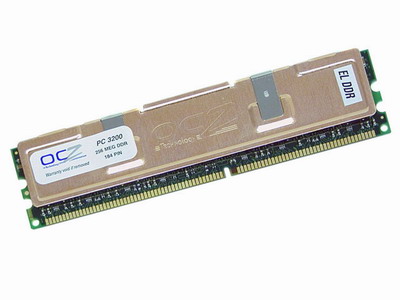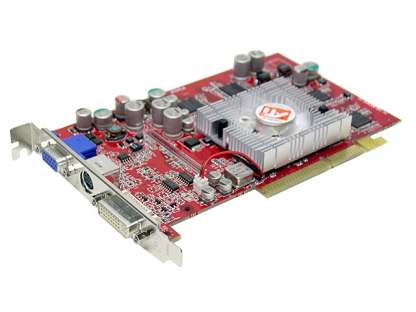Weekly Buyer's Guide: Mid-Range System - May 2004
by Evan Lieb on May 20, 2004 12:05 PM EST- Posted in
- Guides
Memory
Recommendation: 2 X 256MB OCZ PC3200 EL (Enhanced Latency) CAS2.0Price: $135 shipped

We've talked about OCZ's troubled past and history in detail before, but thankfully, those issues have been resolved and OCZ is finally able to bring great memory to market, and has been doing so for over a year now. With that said, OCZ has had tremendous success with their EL series of modules for a reason: great price/performance ratio. At only slighty more than the Kingston ValueRAM that we recommended two months before, you get lower CAS timings (CAS 2-2-3 1T) with OCZ EL modules instead of high CAS timings (CAS 3-3-3 4T) with the Kingston ValueRAM modules. Lower CAS timings along with the EL series' overclocking capability translates into better performance for a great price.
Alternative: 2 X 256MB Mushkin PC3500 Level One Dual Pack (CAS2)
Price: $168 shipped (shipped together in same package)

We've recommended Mushkin's Level One memory in other Buyer's Guides due to its great performance, overclockability, and price, and that is exactly why we are recommending it in this Buyer's Guide today. However, we are recommending the 256MB versions instead of the 512MB versions that we had recommended before because this Buyer's Guide concentrates on mid-range systems where 1GB of memory (2 X 512MB) is usually overkill and users are still fairly sensitive to price. Basically, these modules give you an extra 33MHz (433MHz versus 400MHz) in speed and a lower latency (CAS 2-3-3 instead of CAS 2.5-4-4). You will experience a boost in speed, without any doubt, but how much depends on what programs you use. If you game a lot, the extra clock frequency and lower latencies of the Level One modules will definitely be useful. If not, you will probably not notice any difference in performance whatsoever.
Video
Recommendation: 128MB PowerColor Radeon 9600 Pro, DVI, TV-outPrice: $133 shipped

Ever since the release of the ATI R300 cores and their later iterations, ATI has either led or has had a clear lead over NVIDIA in terms of performance and price. The same is still true of ATI at the moment, a whole 18 months since the release and availability of R300 core video cards. That's why, today, we highly recommend purchasing a 9600 Pro for your mid-range system, as it offers great DX8 and good DX9 performance for the price. To put it simply, the 9600 Pro is the best bang-for-the-buck video card on the market. PowerColor makes a nice 9600 Pro for just $124 or so shipped; the additions of DVI and TV-out for this price are unique, and overall, a great deal. 2D IQ quality is excellent, up to 1600x1200 desktop resolutions with the right monitor, essentially on par with retail ATI versions of the 9600 Pro. As previously mentioned, 3D performance is excellent in DX8 games and good in DX9 games, and 128MB of memory will be plenty until more intense DX9 games are released later this year and next year.
Of course, if you're not a gamer or don't plan on playing games more than once a year, or ever, a 9600 Pro would be a pointless purchase. We would instead suggest the ATI Radeon 9200SE that we recommended last week, which goes for about $40 shipped online currently. The 9200SE provides the excellent 2D quality non-gamers need, along with reliable drivers, great online ATI customer support, and up to DX8.1 support for future Microsoft operating systems. You could always opt for the cheapest of cheap ATI cards in the Radeon 7000, but you won't be getting DX8 support, which should be the bare minimum for computer systems that plan to be used beyond the next 18-24 months, when the next operating system's release will necessitate DX8 of some form for smooth operation.
Finally, we should mention that we are getting extremely close to seeing Radeon X800 cards and their entry level/mid-range iterations any week now. ATI's next generation mid-range card has been dubbed the Radeon 9550 and promises to provide significantly better performance at a reasonable (mid-range) price point. Some 9550 cards are already available, in very limited quantity, but we highly suggest that you wait for more extensive reviews and mature drivers before delving in head first.
Alternative: 128MB ATI Radeon 9800 Pro, DVI, TV-out
Price: $193 shipped

ATI's 9800 Pro has been rapidly declining in price for the last several months, and just last month, stabilized around the $200 mark. Even with the introduction of ATI's next generation X800 GPU, we don't see the 9800 Pro dropping more than a few more dollars in retail from where it stands now for the foreseeable future. ATI's soon-to-be widely available X800 GPU and the 9800 Pro's lower price are precisely why we believe that the 9800 Pro is a perfect alternative to the 9600 Pro (or even 9700 Pro) for your mid-range system. It offers good performance for tomorrow's games and great performance for the vast majority of today's games. The 128MB memory chips at their rated 3.3ns is standard these days and should fit the needs of a mid-range user. Thankfully, 2D IQ is still superb with high end retail ATI video cards like the 9800 Pro, so non-gamers have nothing to worry about in that department.
Listed below is part of our RealTime pricing engine, which lists the lowest prices available on ATI video cards from many different reputable vendors:
If you cannot find the lowest prices on the products that we've recommended on this page, it's because we don't list some of them in our RealTime pricing engine. Until we do, we suggest that you do an independent search online at the various vendors' web sites. Just pick and choose where you want to buy your products by looking for a vendor located under the "Vendor" heading.










25 Comments
View All Comments
qquizz - Friday, June 25, 2004 - link
I would go with the Barton 2500+ if your an overclocker. Overclocks better/same as 2800+ according to overclockers.com database.$75 OEM
yankee428 - Thursday, June 10, 2004 - link
1. I have some friends who comment that they used AMD over Intel recently and needed to go out and get fancy cooling systems because AMD runs hot. This cost them about $30 and basically blew the saving that motivated them to choose AMD in the first place.2. Often you quote a price on proc's in your guide, but that price is usually for OEM chip only. Does not include the cooling system.
slurmsmackenzie - Tuesday, June 8, 2004 - link
funny....i read a review in here that put the asus sis655tx as equal or better that most of it's 865 875 counterparts. including the p4p800. while being 15% cheaper. i know the price is higher, but the oc'ing capability on the 2.8 is the hands down favorite for me. i'm a mutitasking encoding junkie! divx rocks!
D9r - Saturday, May 29, 2004 - link
You recommend the ABIT "AN7" nForce2 Ultra 400 motherboard ($96).How does that compare with the ECS "KT600-A" (VIA KT600 + VT8237 chipset) ($45)? Both seem to have the same or similar features.
http://www.newegg.com/app/viewProductDesc.asp?desc...
jamessmiddleton - Wednesday, May 26, 2004 - link
The one thing that this review seems to ignore regarding the Athlon64 2800 vs. the AthlonXP 2800 is that you will be able to upgrade to a higher clocked Athlon64 in the future while the XP has no upgrade path that does not require a new mobo. This combined with the 64bitness ensure that the Athlon64 rig will have a significantly longer usable lifespan than the XP. Well worth the $80 for a midrange system, in my opinion. I think that the low end Athlon64 should be the midrange proc of choice for some time to come.gherald - Tuesday, May 25, 2004 - link
Well #19 that depends on what you're doing with your system... Intel is clearly better at multimedia encoding and getting insane Quake 3 Arena fps :)MAME - Tuesday, May 25, 2004 - link
no point comparing intel to amd, amd is the clear winner in price and performanceTostada - Monday, May 24, 2004 - link
The summary at the end says "Western Digital 800BB (40GB) $68" ... I'm sure this is a typo, seeing as the WD800JB 80GB is $68 at NewEgg.I do think it is quite odd that WD drives are always recommended, though. Samsung/Hitachi drives are both quieter and cooler, and Hitachi SATA drives are much faster. Do WD drives even use FD bearings? WD is really behind the times, and I really don't like the way they refuse to tell you the transfer rate and platter count of drives. Sure, the drives they send the review sites have 80GB platters, but when you buy one you might get a drive with 40GB platters, because it's the same model number.
If you're already getting a motherboard with SATA on it, you should be getting a SATA hard drive. The 80GB SATA Hitachi Deskstar 7K250 with 8MB cache and 3-year warranty is $73.25 at NewEgg, and it's extremely fast. It matches the 36GB Raptor in most benchmarks, and is much faster than the WD800JB.
High-End DriveMark 2002:
Raptor 740GD: 585 IO/sec
Raptor 360GD: 467 IO/sec
Hitachi 7K250: 442 IO/sec
WD800JB: 375 IO/sec
StorageReview Gaming DriveMark 2002:
Raptor 740GD: 749 IO/sec
Raptor 360GD: 588 IO/sec
Hitachi 7K250: 588 IO/sec
WD800JB: 477 IO/sec
WB99 Max Read Transfer Rate:
Raptor 740GD: 71.8 MB/sec
Raptor 360GD: 57.4 MB/sec
Hitachi 7K250: 60.4 MB/sec
WD800JB: 49.3 MB/sec
Idle Noise:
Raptor 740GD: 42.3 dB/A
Raptor 360GD: 43.1 dB/A
Hitachi 7K250: 41.5 dB/A
WD800JB: 45.0 dB/A
So, the Hitachi SATA drive is quieter, 25% faster than the WD800JB and costs $5 more. They both have a 3-year warranty.
I've used plenty WD drives, and I can't criticise anybody too much as long as they're smart enough to get something with a 3-year warranty, but in this situation it's ridiculous to suggest the WD drive.
The only other choice is the Raptor 74GB, which is $200.
TrogdorJW - Friday, May 21, 2004 - link
The only reason I would consider an Athlon 64 2800+ would be if it overclocks well. Relative performance against a 2.8C P4 isn't as nice as comparing a 3000+ to a 3.0C P4 or a 3200+ to a 3.0C. And we all know that a 2.8C can overclock like Big Ben on crack.I know this isn't the overclocking system, but with 2500+ Mobile chips costing ~$30 less than the 2800+ and pretty much guaranteed to at least run as fast as the 2800+ with even low end heatsinks, I'm not sure I would stick with Athlon XP on a mid-range non-overclocked system. Either upgrade to a 2.8C P4 or go with the Athlon 64 3000+.
Of course, last time I ran one of my PCs at stock CPU speeds was... hmmm.... 1996, I guess. Pentium 120. *sigh* Those were the days.....
crimson117 - Friday, May 21, 2004 - link
On the main processor page, you say that while the Athlon 64 2800 is nice, at it's too expensive compared to the price/performance of the Barton 2800.Recommended mobo/cpu:
Barton 2800 ($120) + AN7 ($96): $216
and the alternative mobo/cpu is:
P4 2.8C ($179) + ASUS P4P800 Deluxe ($119) = $298 ($83 more than barton)
But you could get a A64 2800 with lan/audio mobo for about the same money as the pentium alternative!
Shuttle nForce3 150 AN50R ($125 shipped at ZipZoomFly) + A64 2800 Retail ($184 shipped at ZipZoomFly): $309 ($94 more than barton)
So for $11 more than your P4 alternative, you have 64-bit capability. I think anyone building a midrange system would appreciate getting next generation technology for $11 more, and it would be a more meaningful "alternative" than a P4 since not only would you get more speed, you'd get an entire new class of capabilities.